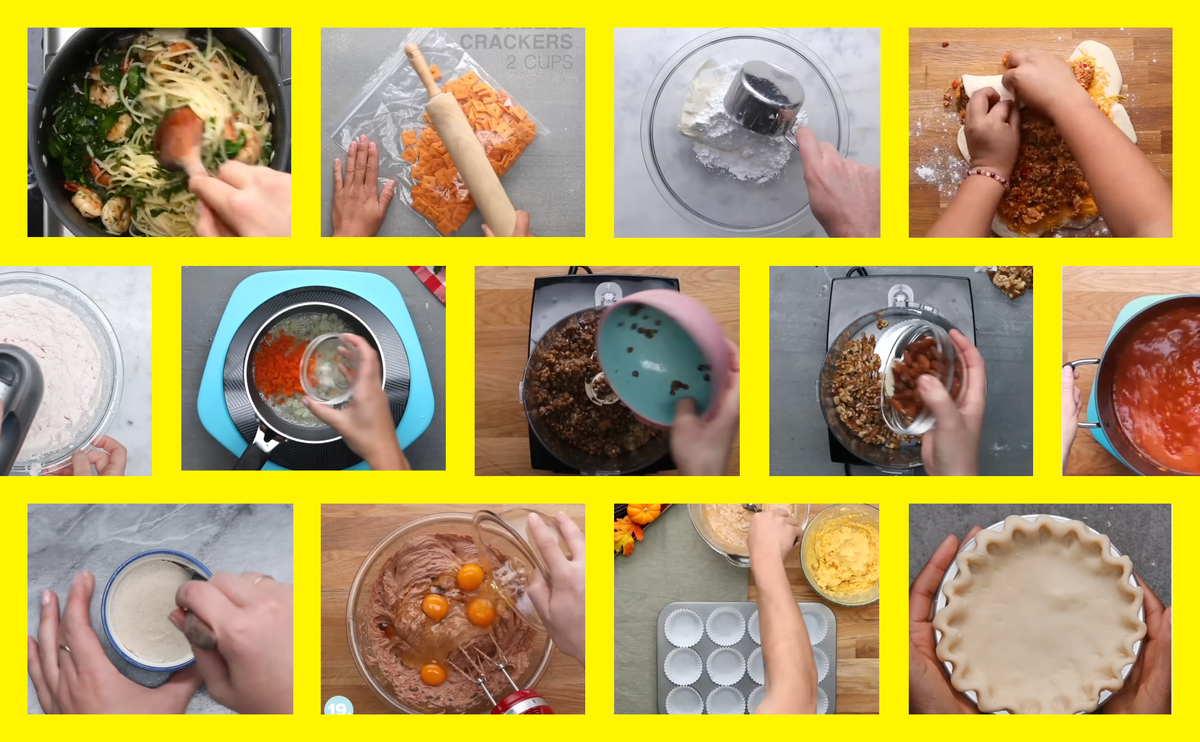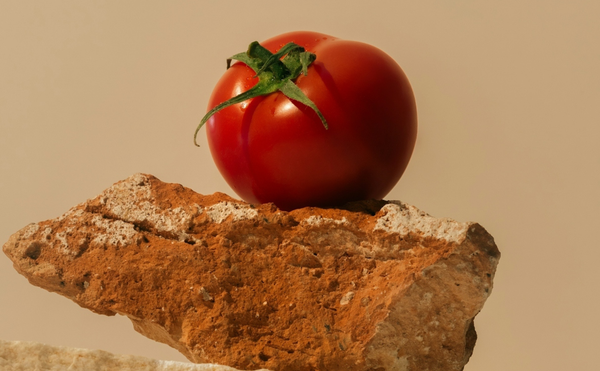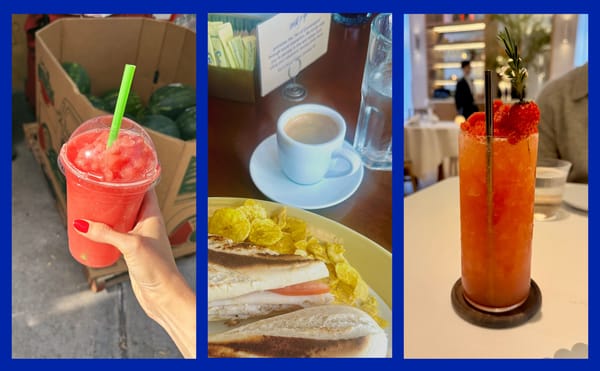The 2010s Video Frenzy That Changed Food Forever
Hands-and-pans videos created our appetite for short clips. What did they leave behind?

Even if you think you don’t know what “hands-and-pans” means… you know what it means. In the BuzzFeed-clickbait-Hamilton-hopecore-Obama era of Lana Del Rey’s internet, there was no escaping it. Disembodied hands assembling Dr. Pepper Poke Cake. Disembodied hands cooking Cheddar Bacon Waffles and Flamin’ Hot Cheetos Jalapeño Poppers. Disembodied hands making Cheesy Stuffed Wonton Nachos, Rainbow Hummus, and Stuffed Fried Pickles.
Whether you were a “foodie” or not in 2015, you probably consumed short-form cooking videos online. (Possibly while watching HBO’s “Girls” every Sunday night.)
It’s been 10 years since the heyday — or reign of terror, depending on who you ask — of the rapid-fire dissemination of hands-and-pans clips. The fickle Algorithm Gods have since moved on to prioritize sponcon, emotionally evocative voiceovers, goofy personalities, AI ragebait, and split-screen 40-second Family Guy clips instead of the royalty-free-music-backed birds eye view of cooking. Beyond that errant video of “Brieghetti Pie Dinner” you stare at, eyes glazed over, on the rush-hour 7 train, they’re all but a memory.
But for those of us who have been in the trenches of food content creation, these videos have left an indelible mark. And, there’s no denying the hands-and-pans frenzy of the 2010s set the stage for the tenets of today’s messy, cacophonic, colorful, and supersaturated world of food video content. Let me count the ways.
Quantity, gimmicks, and divisive engagement
It’s impossible to talk about the hands-and-pans phenomenon without addressing the BuzzFeed Tasty-sized elephant in the room. With a reliably gangbusters video format, billions of views, a captive audience on Facebook’s news feed, and the ability to charge a premium on ads, Tasty was undeniably on top. And when you’ve got a model like that, you milk it for all its worth.
“I started as an intern, so my motivation was simple: Make videos that went viral so I could get hired,” Alix Traeger tells me in an email. Traeger, the author of Scratch That, was a video producer and on-screen talent at Tasty from 2016 to 2020, regularly producing three recipe videos a week.
"A lot of the content was created not because it was a good recipe that would be of use to an everyday home cook, but because the content would elicit some sort of reaction that would then bring more views and engagement."
“We were doing everything ourselves,” she writes. “Coming up with ideas, developing and testing recipes, setting up our stations, operating two cameras and lights while we cooked, cleaning up, and then heading downstairs to edit. It was a grind. But I loved it.”
As other brands attempted to strongarm their way into the then-lucrative hands-and-pans space, it got messy. It became difficult to differentiate between all the players when all of the videos looked so similar — especially from the vantage point of a speed-scroll through your news feed.
“I think working in food media in the late 2010s was just an endless attempt to live up to hands-and-pans Tasty content,” writes Sara Tane, a private chef and recipe developer based in Los Angeles, in an email interview. In 2017, Tane and I were colleagues at Well Done, legacy media company Time Inc.’s bite-sized recipe video vertical.
“Quantity over quality definitely felt like the name of the game,” she writes. “A lot of the content was created not because it was a good recipe that would be of use to an everyday home cook, but because the content would elicit some sort of reaction that would then bring more views and engagement.”
As social media editor at Well Done, I too remember sitting in meetings where ideation often took a decidedly, um, gross turn. Recipes like chocolate mashed potatoes and pepperoni popsicles were a blatant attempt to grab audiences’ attention when the brand needed a boost. And no, these were not April Fool’s Day plays.
Of course, the goal was still for most of these wacky creations to taste good. “I wouldn’t say I was necessarily opposed to that way of brainstorming,” writes Tane. “I remember I really wanted to do a pickle ice cream video because it would obviously be divisive in the comments, but I also remember feeling a sense of pride knowing that it actually was pretty good.”
Flooding the space and relying on visual gimmicks — sound familiar? The 2010s ecosystem laid today’s audiences’ expectations of unlimited recipe videos and our insatiable appetite for can’t-look-away food content, brick by brick.
Playing to the whims of social media behemoths
Before Facebook started prioritizing video on its news feed, publishers could host food videos and sell ads on their own websites in a format of video known in the industry as “O&O,” or “owned and operated,” giving them marked autonomy.
But with the sheer number of Facebook users (and very dubious metrics that were falsely inflated by up to 900 percent), it became untenable for O&O videos to even come close to the views — and ad sales — a viral video could get on social media. Mention the phrase “pivot to video” (a reference to the Facebook algorithm moving to aggressively prioritize short-form clips on people’s feeds) to any millennial media professional, and it’s likely to send chills down their spine. This shift meant food brands had to play by Zuckerberg’s rules if they wanted to get views.
"We always knew the landscape could shift at any moment, and we had to evolve fast."
“I remember there was always just a looming fear of coming into work every day and wondering what new algorithm change or app update we’d learn about from Facebook or IG,” writes Tane of her time as assistant editor at Well Done.
As a social media editor at the brand, I remember a post-it note on my computer screen getting increasingly chaotic as I scribbled down the ever-changing specs a single hands-and-pans video would need to be cut to for Instagram feed videos, IGTV, Instagram stories, Facebook Watch, and whatever other format was the Zuck-enforced flavor of the day.
“Change is hard in any work environment, and it just required a sense of adaptability that can be frustrating at times,” writes Tane. “It’s like, you spend all this money and resources on hosted IGTV content, and now that platform doesn’t even exist. Lol, RIP.”
Flash forward to today’s content economy: Independent food creators can’t scratch together a profit on recipe videos on YouTube and Instagram despite investing thousands of dollars, and apps like TikTok can be yanked from under our feet and then reinstated on a moment’s notice. In such a shaky ecosystem, where are food content creators supposed to find and build their audience in a way that’s sustainable?
“We always knew the landscape could shift at any moment,” writes Traeger, the author and former BuzzFeed Tasty producer, “and we had to evolve fast.”
Amateur cooks have the last laugh
Tasty wasn’t conceptualized by food professionals. “It was a team of (mostly) video people who didn’t really know how to cook but loved food,” writes Traeger. “A few BuzzFeed Video guys decided to try making food videos, and it took off immediately. The iconic “oh yes” at the end of every video? That was Andrew Ilnyckyj’s (producer at BuzzFeed Video at the time) genuine reaction to a burger’s egg yolk break. Everything about it was real and raw.”
Pre-2010s food content used to be mostly educational, created by trained culinary professionals for audiences who were specifically seeking it out and had a vested interest in cooking. Then, hands-and-pans videos broke that barrier. They were quick and cheap to produce. They didn’t rely on the authority of on-screen personas. And it was easier than ever to mindlessly autoplay, absorb by osmosis, and drool over a well-shot cheese pull without even the slightest impetus to get into the kitchen.
There’s no denying that today’s food video ecosystem is more democratic, globalized, visually dynamic, diverse, and approachable than it ever was before the era of hands-and-pans.
“I have never met a single person who has tried to execute a Tasty recipe — I have certainly never tried one myself,” wrote Alexandra Jones in a 2018 article for The Guardian about “the boiled-down recipe videos cooking up a storm.”
But for the young recipe developers in the midst of it all, it was an opportunity for unfettered, experimental, and low-stakes creativity.
“I think we helped create space for food content that wasn’t just about perfection or technique,” writes Traeger. “It was about stories, mistakes, nostalgia, fun. We cracked the code on how to make people fall in love with cooking by making it feel approachable and emotional. Before Tasty, most recipe videos felt like instructional tapes. We turned them into entertainment, comfort, and inspiration — all in under a minute.”
Tane also looks back favorably on her foray into hands-and-pans videos. “What these videos are good at is simplifying the process (for better or for worse) and making cooking seem more attainable because you're watching it happen right before your eyes,” she writes. “They became popular at a time when I was learning how to cook and I remember finding it so helpful and illuminating to watch a video of, say, making homemade pasta and going…oh, that’s all it is?”
There’s no denying that today’s food video ecosystem is more democratic, globalized, visually dynamic, diverse, and approachable than it ever was before the era of hands-and-pans. The DNA of that 2010s video format is inextricably interwoven in the content of innumerable food personalities, cookbooks, cooking shows, and formats of food storytelling today.
But when the dust of the BuzzFeed x Facebook video boom finally settled in 2019, we were also left with a lot to contend with. For starters, a new, voracious, collective appetite for an infinite scroll of shocking (and attainable) cooking videos. But also the expectation by an audience that this content would — and should — be forever free.
Meta, YouTube, and TikTok platforms aren’t paying up like they used to. It’s why your favorite food content creators are launching paid-only newsletters; why influencers are jumping on every lucrative marketing partnership they can get; and why your favorite recipe sites now have their cooking content tightly locked behind a subscriber-only paywall. In 2025, The Gold Rush of “pivot to video” has solidly run dry.
As for what iteration of short-form food content is next in line to melt our brains? Well, gird your loins. Your guess is as good as ours.




